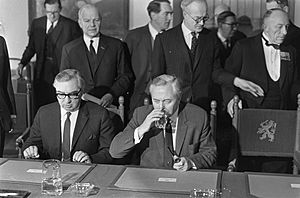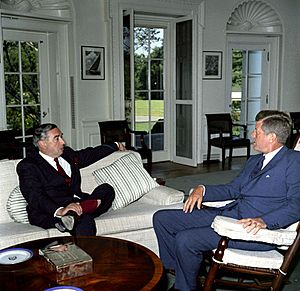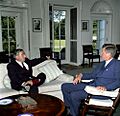George Brown, Baron George-Brown facts for kids
Quick facts for kids
The Lord George-Brown
|
|
|---|---|

Brown in 1967
|
|
| Foreign Secretary | |
| In office 11 August 1966 – 15 March 1968 |
|
| Prime Minister | Harold Wilson |
| Preceded by | Michael Stewart |
| Succeeded by | Michael Stewart |
| First Secretary of State | |
| In office 16 October 1964 – 11 August 1966 |
|
| Prime Minister | Harold Wilson |
| Preceded by | Rab Butler (1963) |
| Succeeded by | Michael Stewart |
| Secretary of State for Economic Affairs | |
| In office 16 October 1964 – 11 August 1966 |
|
| Prime Minister | Harold Wilson |
| Preceded by | Office created |
| Succeeded by | Michael Stewart |
| Deputy Leader of the Labour Party | |
| In office 15 July 1960 – 19 June 1970 |
|
| Leader |
|
| Preceded by | Aneurin Bevan |
| Succeeded by | Roy Jenkins |
| Leader of the Opposition | |
| In office 18 January 1963 – 14 February 1963 |
|
| Monarch | Elizabeth II |
| Prime Minister | Harold Macmillan |
| Preceded by | Hugh Gaitskell |
| Succeeded by | Harold Wilson |
| Minister of Works | |
| In office 26 April 1951 – 26 October 1951 |
|
| Prime Minister | Clement Attlee |
| Preceded by | Richard Stokes |
| Succeeded by | David Eccles |
| Member of Parliament for Belper |
|
| In office 5 July 1945 – 29 May 1970 |
|
| Preceded by | Herbert Wragg |
| Succeeded by | Geoffrey Stewart-Smith |
| Member of the House of Lords Lord Temporal |
|
| In office 10 November 1970 – 2 June 1985 Life peerage |
|
| Personal details | |
| Born |
George Alfred Brown
2 September 1914 Lambeth, London, England |
| Died | 2 June 1985 (aged 70) Truro, Cornwall, England |
| Political party | |
| Spouse |
Sophie Levene
(m. 1937; separated 1982) |
| Children | 2 |
|
a. Office vacant from 18 October 1963 to 16 October 1964.
|
|
George Alfred George-Brown, Baron George-Brown (born 2 September 1914 – died 2 June 1985), was an important British politician. He was a member of the Labour Party. He served as the Deputy Leader from 1960 to 1970. He also held several important jobs in the government under Prime Minister Harold Wilson. These jobs included Foreign Secretary and First Secretary of State.
After finishing school at 15, George Brown started working as a clerk. He then joined a large workers' group called the Transport and General Workers' Union. He quickly moved up in the union. Before the 1945 election, he was chosen as the Labour Party candidate for a place called Belper. He won this election and kept his seat until he lost in the 1970 election.
He was briefly a minister in the government in 1951. After Labour lost power, he became part of the Shadow Cabinet. He was seen as a leader for the part of the Labour Party that supported trade unions. In 1960, he was elected to be the Deputy Leader of the Labour Party.
Three years later, in 1963, George Brown became the temporary leader of the Labour Party. This also made him briefly the Leader of the Opposition. He tried to become the permanent leader but was beaten by Harold Wilson. When Labour won the election in 1964, Wilson made Brown the First Secretary of State. This made him the second most important person in the government. He was also given a new job as Secretary of State for Economic Affairs.
In 1966, after Labour won another election, Wilson moved Brown to the job of Foreign Secretary. This was a job Brown had always wanted. After some disagreements with Wilson in 1968, Brown decided to resign. He lost his seat in Parliament in 1970. Soon after, he was given a special title and became a member of the House of Lords. He chose the title Baron George-Brown.
Contents
Early Life and Work
George Brown was the oldest of four children. He was born in Lambeth, London, in 1914. His family lived in a working-class housing area. His father worked as a driver and later as a fur salesman. His father was also a strong supporter of trade unions. He was even a leader in the Transport and General Workers' Union.
Brown went to Gray Street Elementary School. He did well and passed an exam to go to West Square Central School. This was a junior grammar school. Brown had similar political ideas to his parents. He said he delivered leaflets for the Labour Party when he was only eight years old.
The school wanted Brown to stay longer, but he decided to leave at 15. He wanted to earn money to help his family. He started as a clerk but lost his job for trying to get his co-workers to join a union. From 1932, he worked as a fur salesman. He learned a lot and earned good money. During this time, he kept learning by going to evening classes. Because he grew up poor, Brown later felt annoyed by people who had easier lives and went to university.
Joining the Union
In 1937, George Brown married Sophie Levene. Soon after, he got a job as a clerk with the Transport and General Workers' Union. The next year, he became a District Organiser for the union. Brown was very active in the Labour Party's youth group. He tried to become its leader but lost. In 1939, he gave a strong speech at a party meeting.
When World War II started in 1939, Brown wanted to join the Royal Air Force. However, Ernest Bevin, who was the Minister of Labour, kept Brown and other union officials in their jobs. Brown also worked as a temporary government worker in the Ministry of Agriculture from 1940.
Becoming a Member of Parliament
As a union official, Brown was a good choice for Labour Party areas looking for a candidate. This was because his union would help pay for his election costs. He was chosen for Belper, a mixed area near Derby. This was a key area Labour wanted to win.
In the 1945 election, Brown won the seat from the Conservatives. He won by a large number of votes. He was invited to a special dinner with other young winners. Brown was quickly chosen to be a Parliamentary Private Secretary (PPS) for George Isaacs, the Minister of Labour.
Brown was good at understanding political issues and explaining them. He was also friendly and popular with other Labour politicians. He briefly worked as PPS for Chancellor of the Exchequer Hugh Dalton in 1947. At this time, Britain's economy was still struggling. Brown tried to get Clement Attlee replaced as Prime Minister, but it did not work.
Working in Government
Even though Attlee knew about Brown's plan, he still made Brown a junior minister in the Ministry of Agriculture. Attlee thought it would be good to keep Brown busy. Brown worked to pass the Agriculture Act 1947. This law helped farmers by supporting prices and increasing food production. Attlee began to see how talented Brown was.
When his friend Bevin died in 1951, Brown was made Minister of Works. This meant he was in charge of a government department, but not yet in the main Cabinet. Brown successfully solved a long-running problem. He managed to get the Tower of London opened to tourists on Sundays.
In Opposition
Brown stopped being a minister when Labour lost the 1951 election in October. Like other former Labour ministers, Brown did not earn much money from his parliamentary salary. He thought about going back to being a union official. However, in 1953, he was hired as a consultant for a newspaper group. This allowed him to stay in politics.
Brown was very involved in the Labour Party's arguments in the early 1950s. He was against a group called the "Bevanites." He was known for being good at campaigning. He was also known for being rude to people he disagreed with. After the 1955 election, Brown was elected to the Shadow cabinet for the first time. In December, his friend Hugh Gaitskell became the Labour Party Leader. This made it easier for Brown to get promoted.
In 1956, Brown had a public argument with Soviet leaders Nikita Khrushchev and Nikolai Bulganin. This happened when he was part of a Labour Party group visiting Britain. In October that year, he lost an election to become the Treasurer of the Labour Party.
Deputy Leader of the Labour Party
When Aneurin Bevan died in 1960, the job of Deputy Leader of the Labour Party became open. At this time, the Labour Party was very divided. Brown was encouraged to run as the candidate for the right-wing part of the party. He won the election, beating the other candidates.
As Leader, Gaitskell, and as Deputy Leader, Brown, were not seen as a balanced team by many on the left of the Labour Party. Brown was challenged for his job in 1961 and 1962. Part of his job was to improve Labour's campaigning in special elections. He was successful in winning several of these.
When Gaitskell died suddenly in January 1963, Brown was expected to run for party leader. However, he did not start his campaign well. At the first meeting after Gaitskell's death, Brown and his rival Harold Wilson agreed to a fair contest. Wilson then told the press that they had both agreed to serve under each other. Brown denied this agreement, which made him look bad.
Key Government Roles
Labour won the 1964 election with a small majority. As planned with Wilson, Brown was given a new job as Secretary of State for Economic Affairs. He also became Deputy Prime Minister in October 1964. They hoped this new department would help plan the economy for the long term. They also wanted to reduce some of the power of the Treasury.
When Brown took office, he learned that the government's money problems were much worse than expected. The main economic ministers had to choose between several options, including changing the value of the British pound sterling. They decided to put a temporary tax on imported goods. Brown later felt that not changing the pound's value was a mistake. The pound continued to be under pressure in 1965. Brown worked hard to convince workers' unions to accept a tougher policy on prices and wages.
The most important job of the Department of Economic Affairs was to create a "National Plan" for the economy. Brown was very involved in this project. The plan was revealed in September 1965. It promised to cover "all aspects of the country's development for the next five years." The plan aimed for a 25% growth in the country's economy from 1964 to 1970.
Disagreements and Resignation
After the 1966 election, where Labour won by a lot, the government faced a big money crisis. The idea of changing the pound's value came up again. Brown strongly supported it, but Harold Wilson was against it. Wilson preferred to cut spending and raise interest rates. Brown believed these actions would harm the economy. When the government voted against changing the pound's value, Brown sent a letter saying he would resign.
Wilson sent the letter back to Brown. He also sent someone to talk Brown out of resigning. This news still reached the public. Brown then decided to stay and accepted Wilson's terms. He announced his "un-resignation" to the press.

Brown became Foreign Secretary in August 1966, a job he really wanted. Some of his colleagues thought he wasn't quite right for the job. This decision affected the government's view on the European Economic Community (EEC). Brown had always wanted Britain to join the EEC. Wilson had been unsure, but Brown convinced him and the Labour Party to support applying to join. In May 1967, Britain applied to join the EEC for the second time. Like the first time, Charles de Gaulle of France said no.
In March 1968, the pound was again in trouble. Wilson wanted to declare a special bank holiday to help. He tried to reach Brown, but Brown could not be found. Wilson held a special meeting without him. Brown was very angry that Wilson had not tried harder to contact him. He confronted Wilson at a meeting. Brown shouted at Wilson, who was also angry. At the end of the meeting, Brown stormed out.
It was not clear if he had resigned, but Brown did not apologize the next day. That evening, he sent a letter saying, "I think it better that we should part company." It did not use the word "resignation." Wilson decided to accept it as a resignation. Brown did not change his mind, so he left the government.
After Parliament
Brown's area, Belper, had changed a lot since he was first elected. Many new homes were built for middle-class voters who usually supported the Conservative Party. Even though a report suggested getting rid of the seat, the government delayed the changes. So, Brown had to run in an area that was becoming less supportive of his party. Also, he was still Deputy Leader of the Labour Party. He traveled around the country giving speeches for other Labour candidates during the 1970 election. His Conservative opponent had spent four years working in the area. Brown lost his seat by more than 2,000 votes.
In his speech after the result, Brown said he would "lend" his constituency to the Conservatives.
Becoming a Lord
Brown quickly decided not to try to win his seat back. He was given a special title and became a life peer in the House of Lords. When this was announced, Brown told the press, "I hope to everybody, I will simply remain George Brown." This led to a long discussion about his title. Brown wanted to be "Lord George Brown." However, the official in charge of titles said that titles usually only included surnames, not first names. Brown disagreed, pointing out other examples. In the end, the official agreed, but only if Brown changed his last name to George-Brown. So, his title became Baron George-Brown.
In 1971, he published his life story, called In My Way. When he heard the title, Harold Wilson reportedly said it was very fitting, because that was always where he found George Brown. Brown found work at a textile company and later for other businesses.
In 1976, George-Brown announced he was leaving the Labour Party. He did this to protest a new law that he disagreed with.
In 1981, George-Brown became the president of a group called the Social Democratic Alliance. He also supported the Limehouse Declaration. However, he did not officially join the Social Democratic Party (SDP) for another four years. By that time, his reputation had declined. One politician said he was "an embarrassment rather than an asset" to his old friends who started the SDP. His brother, Ron, who was also a Labour MP, joined the party too.
In 1978, George-Brown hired Kathy Mason as his personal secretary. She worked for him until 1980. Then, Maggie Haimes took over the job. In 1982, after 45 years of marriage, Brown left his wife and moved in with Haimes. However, he did not change his will, which still left his money to his wife.
Later Life and Death
As his health got worse, George-Brown changed his religious beliefs and became a Roman Catholic. He died on 2 June 1985, after a stroke. He was cremated in London, and his ashes were buried under a rose bush. He was survived by his wife, Sophie, and his two daughters.
Images for kids





